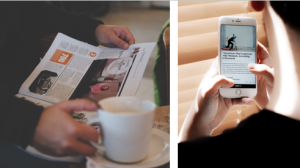As a creative writer, I was well aware that language is key when creating any kind of text. Rather it be a short story, poem, or article, word choice is extremely important. It determines how the writing is received by the reader. However, after my review of Multimodality and how it works in Kristin Arola’s Writer/Designer: A Guide to Making Multimodal Projects, I learned that various kinds of text can contain several different modes, therefore making them Multimodal. The reading affirmed some of my beliefs, but it also lead me to ask the questions of how Multimodality differs from print to digitally published works?
Modes help further develop the story and or message the author wants to convey to the readers and intended audience. As I mentioned, linguistics is an important mode, but it is just one of the many that bring a piece of communication to life. The example used by Arola to explain how multiple modes can, in a sense, complement one another, made things much easier to grasp. Arola mentions, “…the modes at play in a simple TV commercial – there usually is music, the voice of an announcer, video showing the product, text on the screen…” (12). This made Multimodality much clearer to me. Being a film and television enthusiast, the idea clicked for me instantly. The modes in this television commercial she mentions would be, linguistic mode, which are the text/words the viewer would have to read on screen, visual mode, the video of the product and or people engaging with it, and lastly, aural mode, which would be the sounds of music and the announcer’s voice.
I was already aware and agreed with the idea that appealing to our different senses helps bring stories and communications to life. The commercial mentioned would appeal to both or sight and hearing, thus putting the person watching in a certain kind of mood, thus persuading them to buy the advertised product. Just like in a horror movie, the lighting would be low, the music would be unsettling, and we’d likely see a sweaty panicked person on screen. This is all to make the view as terrified as the character seems to be in the film, thus selling the movie.

So now that I know appealing to the senses is key, I wanted to know how Multimodality differs from print to digitally published works. Can’t we use multiple modes and different types of media in both print and digital text to help communicate with the people digesting the material. Yes, but Geoffrey Rockwell and Andrew Mactavish explain that, multimedia combines types of information that traditionally have been considered different media and have therefore had different traditions of production and distribution. Digitization makes it… possible to combine media, especially media that are incompatible in other means of distribution…”. In a nutshell, they are saying it is much easier to put things together digitally than it would be in print. The digital world gives us allowances that print doesn’t.
For example, you can pretty much only use text and images in print media. Not to say this isn’t effective, because font size, color, and word choice combined with an image that also contains those elements can make the piece pop. Positioning moves the eye from place to place, and the look, like color of text matching the color of pictures can be aesthetically pleasing. However, Rockwell and Mactavish made it very clear that, digitally you can do more. You can have text, images, audio and video, all in one communication, therefore adding more modes to enhance the piece.
Word Count: 598
Work Cited:
Arola, Kristin L., et al. “What Are Multimodal Projects?” Writer/Designer: A Guide to Making Multimodal Projects, 2nd ed., Bedford/St.Martin’s, 2014.
Mactavish, Andrew and Rockwell, Geoffrey. “Multimedia.” A Companion to Digital Humanities.